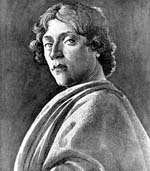1445-1510
 Boticelli
is one of the leading painters of the Florentine Renaissance. He developed
a highly personal style characterized by elegant execution, a sense
of melancholy, and a strong emphasis on line; details appear as sumptuous
still lifes.
Boticelli
is one of the leading painters of the Florentine Renaissance. He developed
a highly personal style characterized by elegant execution, a sense
of melancholy, and a strong emphasis on line; details appear as sumptuous
still lifes.
Botticelli was born in Florence, the son of a tanner. His nickname was
derived from Botticello ("little barrel"), either the nickname of his
elder brother or the name of the goldsmith to whom Sandro was first
apprenticed. Later he served an apprenticeship with the painter Fra
Filippo Lippi. He worked with the painter and engraver Antonio del Pollaiuolo,
from whom he gained his sense of line; he was also influenced by Andrea
del Verrocchio.
Botticelli had his own workshop by 1470. He spent almost all of his
life working for the great families of Florence, especially the Medici
family, for whom he painted portraits, most notably the Giuliano de'
Medici (1475-1476, National Gallery of Art, Washington, D.C.). Adoration
of the Magi (1476-1477, Uffizi, Florence) was painted on commission
(though not for the Medicis), and contains likenesses of the Medici
family. As part of the brilliant intellectual and artistic circle at
the court of Lorenzo de' Medici, Botticelli was influenced by its Christian
Neoplatonism, which tried to reconcile classical and Christian views.
This synthesis may be the theme of two larger panels commissioned for
Medici villas and now in the Uffizi, Primavera (1478?) and Birth of
Venus (after 1482). While scholars have not yet conclusively deciphered
these paintings, their slender elegant figures, which form abstract
linear patterns bathed in soft golden light, may depict Venus as a symbol
of both pagan and Christian love.
In the 1490s, when the Medici were expelled from Florence and the fanatic Dominican monk Girolamo Savonarola preached austerity and reform, Botticelli experienced a religious crisis. His subsequent works, such as the Pietà (early 1490s, Museo Poldi Pezzoli, Milan) and especially the Mystic Nativity (1490s, National Gallery, London) and Mystic Crucifixion (1496?, Fogg Art Museum, Cambridge, Massachusetts), reflect an intense religious devotion.
"Botticelli, Sandro," Microsoft® Encarta® Online Encyclopedia 2001
http://encarta.msn.com © 1997-2000 Microsoft Corporation. All Rights Reserved.
